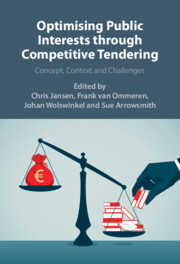Book contents
- Optimising Public Interests through Competitive Tendering
- Optimising Public Interests through Competitive Tendering
- Copyright page
- Contents
- Contributors
- Preface
- Table of Cases
- Abbreviations
- 1 Optimising Public Interests through Competitive Tendering
- Part I Characterising Limited Rights
- 2 Public Procurement
- 3 Licensing
- 4 Subsidising
- 5 Government Sales and Privatisations
- Part II Connecting Limited Rights
4 - Subsidising
from Part I - Characterising Limited Rights
Published online by Cambridge University Press: 11 April 2025
- Optimising Public Interests through Competitive Tendering
- Optimising Public Interests through Competitive Tendering
- Copyright page
- Contents
- Contributors
- Preface
- Table of Cases
- Abbreviations
- 1 Optimising Public Interests through Competitive Tendering
- Part I Characterising Limited Rights
- 2 Public Procurement
- 3 Licensing
- 4 Subsidising
- 5 Government Sales and Privatisations
- Part II Connecting Limited Rights
Summary
This chapter concerns the pursuit of public interests involved in the award of financial grants by public authorities to natural individuals and organisations. The core aim of subsidising is to encourage certain activities being performed while public money is spent in an efficient and lawful way. In order to assess the use of competitive tendering when allocating financial grants, it is necessary to distinguish between grants awarded by EU institutions, in shared management (EU and domestic authorities together) and by domestic authorities. It turns out that the need to use a competitive procedure has been articulated more clearly at the EU level, whereas domestic allocations of financial grants are still subject to non-competitive allocation procedures (first come, first served, lottery) or even to direct award, lacking any call for competition, without proper justification.
Keywords
- Type
- Chapter
- Information
- Optimizing Public Interests through Competitive TenderingConcept, Context and Challenges, pp. 163 - 192Publisher: Cambridge University PressPrint publication year: 2025

